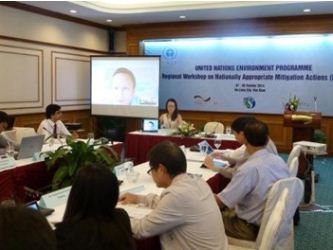Highlights of the Transport-NAMA Session and MRV roundtable meeting from the UNEP Regional Workshop on NAMAs
 On Oct 1-3 GIZ held a thematic session on Transport NAMAs in Ha Long City, Vietnam
On Oct 1-3 GIZ held a thematic session on Transport NAMAs in Ha Long City, Vietnam
Different types of policy instruments are needed to implement the avoid-shift-improve strategy, and NAMAs can help to overcome several barriers (Presentation)
An MRV Roadmap process has been initiated to develop guidance (Reference Document) for countries to establish an MRV system and develop a set of ‘MRV Blueprints for Transport NAMAs’ (Presentation)
Indonesia showed how funding from the NAMA Facility is going to be used to leverage public and private finance for implementation of projects and actions under the SUTRI NAMA (Presentation)
In Thailand, a NAMA identification and prioritisation process led to selection of a NAMA on Public Transport Management and Connectivity, which the Ministry of Transport intends to further develop together with GIZ (Presentation)
Sri Lanka has undertaken a low-carbon study on transport, resulting in identification of possible transport-NAMAs. (Presentation)
The ADB is going to operate a Transport NAMA Support Facility, providing assistance to 10 Asian countries in the development NAMAs in order to link these with existing action/projects, achieve scaling up, and foster regional learning.
As NAMA development is a country-driven process, we are at a stage where developing countries can help in shaping the emerging concepts and to be able to maximize the benefits brought about by NAMA opportunties
Learn more about the discussion in the break-out groups under www.transportandclimatechange.org
Roundtable meeting: GIZ ASEAN regional exchange on MRV for transport NAMAs
Context
• GIZ TRANSfer process on Roadmap for MRV of Transport NAMAs
• At August 2013 Singapore workshop on ASEAN Regional Exchange on Transport NAMAs participants requested more in-depth discussions on MRV
Key Outcomes
An MRV system for the transport sector consists of three related components:
• Transport data used for non-climate purposes such as vehicle-km travelled and modal split
• Carbon emission factors
• Data needed to monitoring specific policies and measures e.g. NAMAs
These need to be consistent and therefore ideally use common methodologies and data sources. Indicators such as gCO2/pkm can help ensure consistency. [Presentation I, Presentation II]
Climate finance can help improve transport data availability, thereby assisting in sustainable transport planning. It’s quite reasonable that a relatively small amount of the total assistance is set aside for MRV. However there may be a chicken-and-egg problem: better data may be needed to access climate finance too, as robust ex-ante analysis is requested by donors.
Tools to estimate emission reductions ex-ante and ex-post are already available and ready to be used with existing data. See e.g. presentation on TEEMP
Other
Whether and how to monitor sustainable development benefits including ‘access’? How to monitor transformational change?
Indonesia has been advancing well in the past years on MRV and monitoring/reporting in the context of the sectoral climate action plan (RAN-GRK) . Other countries can learn from this experience.
The TOD NAMA in Colombia proposes an elaborate MRV mechanism involving a range of different indicators and a control area where TOD is not implemented.
Download here presentations.
Vietnam intends to implement fuel efficiency policies for vehicles, and considers using on-board monitoring equipment installed in new vehicles to monitor actual fuel consumption.
Follow-up
GIZ Transport & Climate Change project continues to work with countries on the MRV system and MRV concepts for particular NAMAs.
More information under www.transportandclimatechange.org
